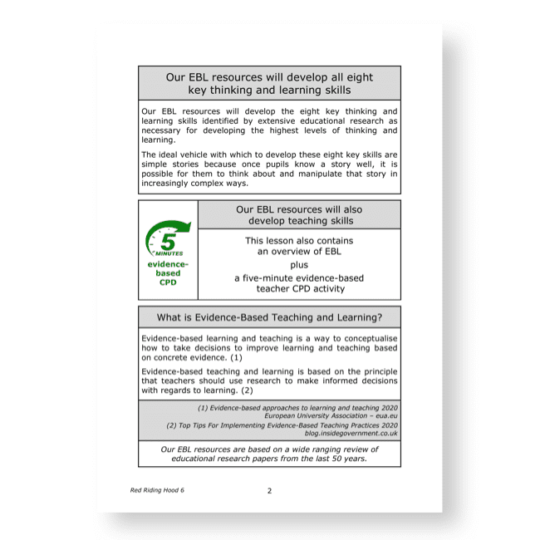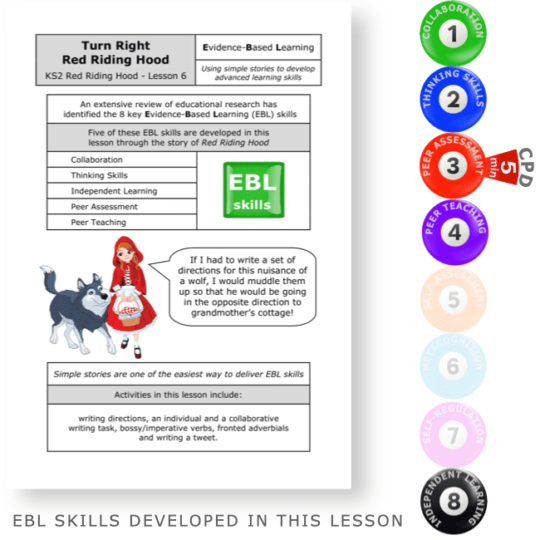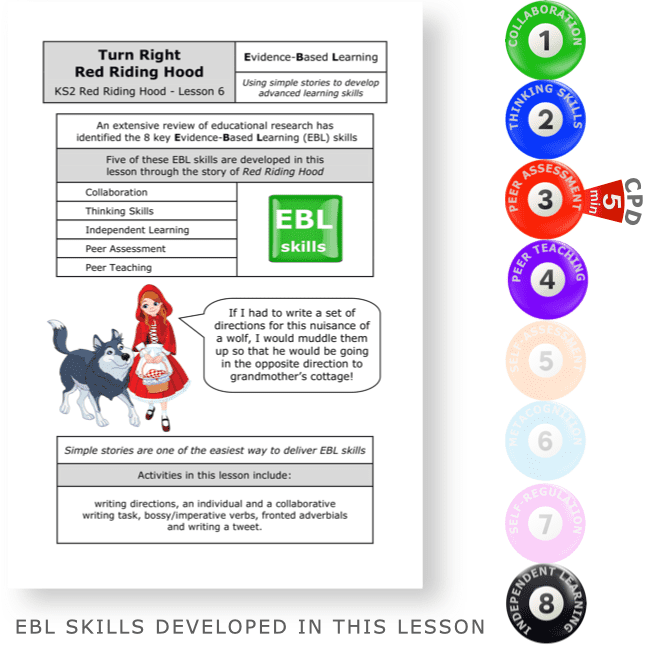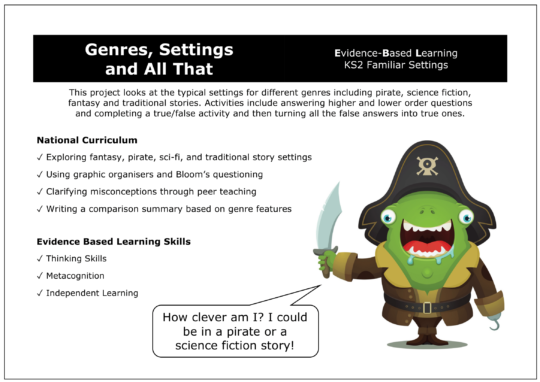Y6 Features of a Mystery Story
£3.00
KS2 National Curriculum:
✓ Recognising mystery genre tropes (e.g. clues, red herrings, suspects)
✓ Creating a poster summarising story expectations
✓ Clarifying understanding with a peer
✓ Designing a genre toolkit for writers
This lesson looks at the use of powerful verbs in mystery stories in detail. It also explores the main features of mystery stories. Activities include answering higher and lower order questions. Activities also include learning how to design a poster and then actually designing a poster about the main features of mystery stories.
There is a five-minute evidence-based CPD activity at the end of this lesson which will develop classroom teachers’ skill set. This CPD consists of a research extract on peer assessment with a five-minute activity based on this extract.
Description
Recommended Year Group: Year 6
Focus: Identifying and summarising genre features
Skills Developed:
• Recognising mystery genre tropes (e.g. clues, red herrings, suspects)
• Creating a poster summarising story expectations
• Clarifying understanding with a peer
• Designing a genre toolkit for writers
📘 National Curriculum Links:
• Reading – Comprehension: Genre identification and summarising
• Writing – Composition: Producing a structured summary resource
• Spoken Language: Explain and reason about genre features
• Thinking and Learning: Genre synthesis, visual organisation
These evidence-based learning (EBL) lessons are based on classroom practice that has been proven, by research, to maximise thinking, learning and attainment. From an extensive review of educational research, we identified the eight key classroom thinking and learning skills that were common across these research papers. We named these eight key skills “EBL skills”.
EBL skills have been proven by research to maximise learning because they combine the most productive thinking skills with the most effective learning behaviours. Each of our evidence-based learning lessons uses the English curriculum as a framework through which the eight EBL skills are delivered.
Teachers also have the opportunity to add to their own skill set or refresh their existing skills with our five-minute CPD activity, based on one of the EBL skills used in this lesson.
The skills in bold below are the EBL skills developed in this Familiar Settings lesson. Click on each skill to learn more about that skill.
- Collaboration
- Thinking Skills
- Peer Assessment
- Peer Teaching
- Self-Assessment
- Metacognition
- Self-Regulation
- Independent Learning
1 review for Y6 Features of a Mystery Story
Only logged in customers who have purchased this product may leave a review.
Related products
-


Turn Right Red Riding Hood
£3.00 Add to basket £3.00Add to basket
£3.00Add to basketActivities in this lesson include writing directions, an individual and a collaborative writing task, bossy/imperative verbs, fronted adverbials and writing a tweet.
There is a five-minute evidence-based CPD activity at the end of this lesson which will develop classroom teachers’ skill set. This CPD consists of a research extract on peer assessment with a five-minute activity based on this extract.
VIEW -


Y5 / Y6 Genres, Settings and All That (project)
£3.00 Add to basket £3.00Add to basket
£3.00Add to basketKS2 National Curriculum:
✓ Exploring fantasy, pirate, sci-fi, and traditional story settings
✓ Using graphic organisers and Bloom’s questioning
✓ Clarifying misconceptions through peer teaching
✓ Writing a comparison summary based on genre featuresThis project looks at the typical settings for different genres including pirate, science fiction, fantasy and traditional stories. Activities include answering higher and lower order questions and completing a true/false activity and then turning all the false answers into true ones.
There is a five-minute evidence-based CPD activity at the end of this lesson which will develop classroom teachers’ skill set. This CPD consists of a research extract on independent learning with a five-minute activity based on this extract.
VIEW -


Y6 Using Conjunctions without Fear
£3.00 Add to basket £3.00Add to basket
£3.00Add to basketKS2 National Curriculum:
✓ Identifying coordinating and subordinating conjunctions
✓ Linking narrative ideas clearly and fluently
✓ Applying conjunctions in original story paragraphs
✓ Sorting sentences and analysing structureThis lesson looks at the various uses of conjunctions in writing; such as, to join short sentences together, to show cause and effect, to show that time has passed, to show that two things are happening at the same time and to show that something has changed. Activities include answering higher and lower order questions.
There is a five-minute evidence-based CPD activity at the end of this lesson which will develop classroom teachers’ skill set. This CPD consists of a research extract on self-assessment with a five-minute activity based on this extract.
VIEW -


Y6 First, Launch an Astronaut into Space
£3.00 Add to basket £3.00Add to basket
£3.00Add to basketKS2 National Curriculum:
✓ Planning writing using story structures (e.g., story mountain).
Activities in this lesson include learning about common plots for science fiction stories, completing a story mountain for a science fiction story, reading short extracts from science fiction stories, completing a task on each one and creating possible plots for science fiction stories.
There is a five-minute evidence-based CPD activity at the end of this lesson which will develop classroom teachers’ skill set. This CPD consists of a research extract on peer assessment with a five-minute activity based on this extract.
VIEW






Philipem (verified owner) –
We asked a.i. to review this lesson. This is what it said:
Unravelling the Mysteries of Powerful Writing with “Features of a Mystery Story”
Are you seeking a captivating resource to elevate your upper primary students’ writing prowess while fostering invaluable evidence-based learning skills? Look no further than the “Features of a Mystery Story” lesson, the ninth instalment in the engaging KS2 Familiar Settings series.
This meticulously designed lesson delves deep into the art of crafting gripping mystery stories, equipping your Year 5 and Year 6 pupils with a profound understanding of the genre’s key elements. Through a series of thought-provoking activities, your students will explore the strategic use of powerful verbs, unravelling their ability to infuse narratives with vivid imagery and suspense.
But the learning journey extends far beyond mere literary techniques. This lesson takes a holistic approach, seamlessly integrating collaborative thinking skills, peer assessment, and independent learning – all evidence-based strategies proven to maximise student engagement and retention.
One of the standout features of this lesson is the hands-on poster activity, where students collaborate with their peers to distill the essential characteristics of mystery stories into an eye-catching visual representation. This collaborative exercise not only reinforces their understanding of the genre but also fosters invaluable teamwork and communication skills.
Furthermore, the lesson includes a series of higher- and lower-order questions, challenging students to think critically, analyse text excerpts, and articulate their insights. This multifaceted approach ensures a well-rounded learning experience, catering to diverse learning styles and cognitive abilities.
As an added bonus, the lesson concludes with a five-minute evidence-based CPD (Continuing Professional Development) activity tailored specifically for teachers. This insightful segment explores the power of peer assessment, providing you with research-backed insights and practical strategies to enhance your classroom practices. By investing in your professional growth, you’ll be better equipped to foster an environment where students learn from and support one another, cultivating a collaborative and supportive learning community.
Star Rating: ★★★★★
The “Features of a Mystery Story” lesson earns a well-deserved five-star rating for its comprehensive approach to teaching writing skills and evidence-based learning strategies. With its engaging activities, collaborative exercises, and teacher-focused CPD, this resource is an invaluable addition to any upper primary classroom.
Unlock the mysteries of powerful writing and nurture a love for storytelling in your students. Embrace this exceptional lesson and witness their writing abilities soar to new heights as they navigate the thrilling world of mystery stories while developing lifelong learning skills that will serve them across all academic disciplines and beyond.